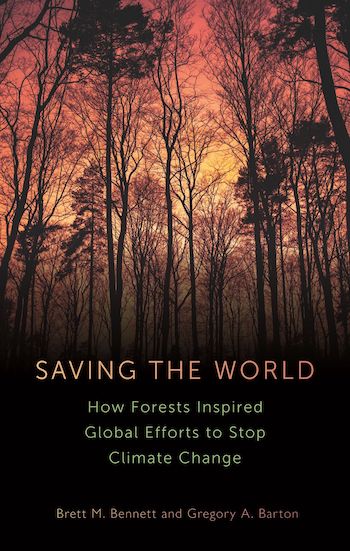As titles go, this is quite a bold one though, to be fair, it has a long explanatory sub-title: How forests inspired global efforts to stop climate change from 1770 to the present. It is then a historical approach to the ideas behind climate change, with a particular focus on the role of trees and it’s a scholarly piece of work by two academics, Brett M Bennett, Associate Professor of History at West Sydney University and Gregory A Barton, Professor of History at the same institution.
They offer some surprising facts. For instance, the idea of climate change and in particular the effect of trees on such change has been around for a very long time not, as many people believe, and as the authors themselves point out, a relatively new idea that emerged some time in the 1970s. In its early days, it was known as climatic botany and began with the idea that large forests were linked to increased rainfall. John Woodward (1665-1728), for instance, believed that countries with extensive forest had “great Humidity in the Air and more frequent Rains than others that are more open and free”.
 This idea had some surprising results. At the time, forests were seen as rather fearful places (just think of the fairy tales where forests contained untold dangers) where creatures such as wolves could attack the unwary traveller. So, rather than planting more trees there was a strong body of opinion advocating they should be cut down. This was notable during the colonisation of America when vast swathes of forest were replaced by plantations – a move much praised by Thomas Jefferson who thought this had had a profoundly positive effect on the climate, in particular that deforestation moderated the harsh winters of the east coast.
This idea had some surprising results. At the time, forests were seen as rather fearful places (just think of the fairy tales where forests contained untold dangers) where creatures such as wolves could attack the unwary traveller. So, rather than planting more trees there was a strong body of opinion advocating they should be cut down. This was notable during the colonisation of America when vast swathes of forest were replaced by plantations – a move much praised by Thomas Jefferson who thought this had had a profoundly positive effect on the climate, in particular that deforestation moderated the harsh winters of the east coast.
In fact, it was a view that wasn’t held long and deforestation was soon regarded as a bad thing especially when Alexander von Humboldt (he of the current) explored South America in the first years of the nineteenth century and found plenty of evidence that human action had, in fact, worsened the climate of the American tropics. Bennett and Barton go on to trace the effects of forestry around the world including a large section on British India where, by a combination of good luck and good management, the effect of the empire was to save a lot of forest that had been under threat.
There is also much discussion of the changing historical thought about the links between forest and climate and where rain comes from. At times, it was thought that the forests themselves held create rainfall by evaporation, at others that this was a negligible influence and all rainfall was generated from the oceans. There were ambitious plans to turn deserts fertile and to manipulate clouds to generate rainfall where it was needed. Other ideas speculated about creating vast inland seas within deserts (in Arizona and Egypt) and indeed whether Mars had itself once been fertile and undergone a process of desertification (and whether the same fate awaited Earth).
The history of ideas is always fascinating and it’s interesting here to see how a subject that is generally though newly coined has actually been around for a very long time and in many different guises. This is, above all, a scholarly, scientific work – be prepared for a lot of references and a huge bibliography. But if the development of scientific thought interests you, there’s plenty of food for thought here on a subject that couldn’t be more topical.
‘Saving the World: How Forests Inspired Global Efforts to Stop Climate Change from 1770 to the Present’ by Brett M Bennett and Gregory A Barton is out now in hardback and e-book, published by Reaktion Books. For more information, please visit www.reaktionbooks.co.uk.
Header photo by Norman Meyer, courtesy of Unsplash




